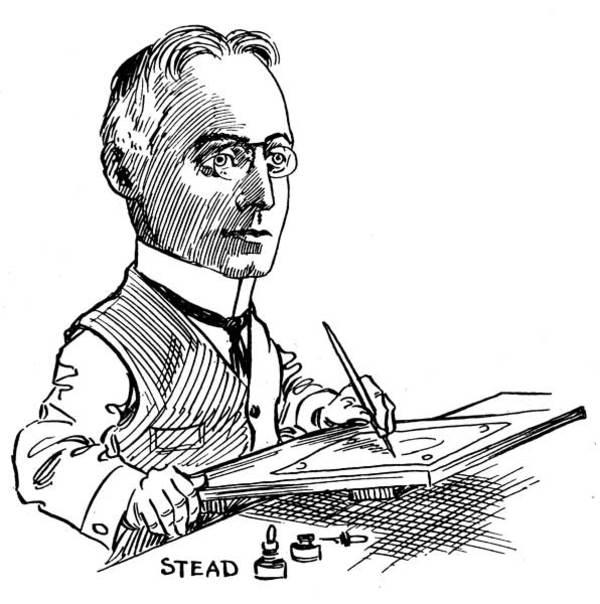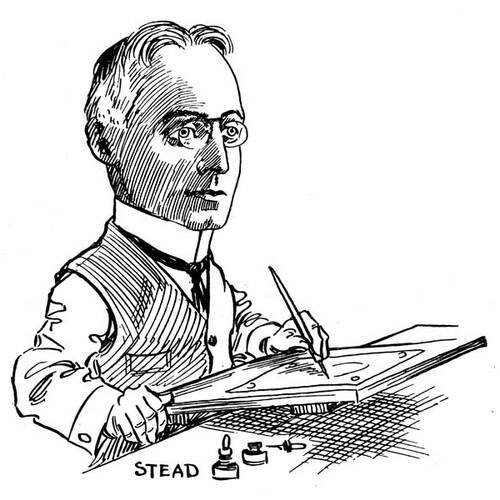
Source: Link
STEAD, HAY STRAFFORD, artist, HBC clerk, and journalist; b. 26 Oct. 1871 in Lancashire, England, one of the five children of George Strafford Stead and Rachel Agnes ——; m. Emily Bertha Earle; they had no children; d. 19 Feb. 1924 in Montreal and was buried there.
Hay Stead came to Canada with his parents as a boy and arrived in Winnipeg presumably in 1889 with his father, who worked as a civil servant in the provincial legislative buildings. Hay farmed in the Gilbert Plains district of Manitoba, perhaps at about that time. By August 1892 he was living in Winnipeg and working as a clerk in the general office of the Hudson’s Bay Company. He left that job in August 1905. From about 1906 until 1922 he worked for the Manitoba Free Press, the Winnipeg Saturday Post, the Winnipeg Telegram, and the Winnipeg Tribune. He held a variety of posts: journalist, editor, editorial writer, feature writer, illustrator, and editorial cartoonist. He also contributed to other publications, including the Winnipeg entertainment weekly Town Topics and Trail, a monthly published in Regina.
Stead’s practice and promotion of the arts in the west had preceded his career in journalism, his artistic side surfacing while he clerked for the HBC. Throughout his career he participated in cultural, literary, and artistic societies, art education programs, and public art exhibitions – teaching, reading papers, commenting on exhibitions, and lending his talents.
A member of the Art and Literature Society, Stead read a paper at one of its meetings in Winnipeg in 1895. That same year local historian, naturalist, and educator George Bryce* sent him to the Manitoba countryside to sketch wild flowers for his textbook Our Canadian prairies. Stead painted scenes for the Winnipeg Operatic and Dramatic Society the following year. In October 1903 he exhibited at Parkin’s Studio with the recently established Manitoba Society of Artists. His submission included a watercolour of a fishing boat on a rough sea which a critic in the Manitoba Free Press called “especially true to nature, the waves appearing to move as one looks at them.” Although the Manitoba Society of Artists had been founded sometime in 1902, it was not until December 1903 that it adopted a constitution. Stead was a founding member and its first president. In its first official show he exhibited an oil portrait entitled A Selkirk native and small watercolour landscapes. One reviewer singled out In the Turtle Mountains and another called Stead’s art careful and clever. His artistic understanding qualified him to critique a loan exhibition displayed in the fine arts section of the Winnipeg Industrial Exhibition of 1904.
At his death Stead was remembered as a “brilliant cartoonist.” Although one of his obituaries would claim that his ability as a cartoonist had brought him into the newspaper business, it may have been the public nature of his artistic activities that gained the attention of the Free Press. As early as 1905 the paper engaged him to provide watercolours to reproduce as covers for an annual Christmas booklet. During 1907 and 1908 he executed numerous illustrations and cartoons for the Free Press; in later years he would work increasingly as an editor. His political cartoons surrounding the provincial election of 1907 echoed the content of newspaper editorials opposed to Premier Rodmond Palen Roblin*; some of the editorials may have been his work as well. He also contributed caricatures of prominent civil servants, businessmen, and professionals for a book produced by the Newspaper Cartoonists’ Association of Manitoba, Manitobans as we see ‘em, 1908 and 1909. Featured in the opening pages along with the other members of the association, Stead portrays himself as dignified and introspective, his collar starched high and rigid. In 1911 he presented to the Western Art Association a paper on caricature, which he defined as “a drawing with the character of the sitter stamped thereon.”
In 1912 Stead taught black and white illustration for the Free Art School sponsored by the Western Art Association and the Manitoba Society of Arts and Crafts. That same year the Industrial Bureau appointed him a member of its newly founded fine arts committee. In addition to organizing local and loan exhibitions for the bureau’s annual fairs, the committee helped to establish the Winnipeg Museum of Fine Arts in 1912 and the Winnipeg School of Art the following year. Stead sat on the committee of management for the school and judged its competition in 1914.
Stead served as temporary curator of the museum, which opened in June 1914 with an exhibit produced by the Western Art Association that featured western Canadian artists who showed “no feeble hankering after old-world atmosphere.” Bold oils and watercolours displaying western scenes of buffalo and prairie landscapes made up Stead’s contributions, including Near Pembina highway, Prairie sunset, The slough trail, and Buffalo at Wainwright, Alta. His watercolours The prairie and The canoe were in the Art Union of Canada’s exhibition of January 1915. After that year Stead’s presence in the local art community faded except for occasional illustrations and cartoons in the Telegram, where he was working primarily as an editor. His work as an editorial cartoonist seems to have drawn him away from artistic societies, or more likely lowered his profile within them. In 1922 he was president of the Winnipeg Press Club; a caricature of him commemorating his service still hangs in the club’s meeting room. The following year he moved to Montreal, where he worked as telegraph editor for the Star. He died there after an illness of four months.
A prominent figure in the developing art scene of the Canadian prairie, Stead had displayed western sensibility as a journalist and an artist. His articles in Trail were serious and diverse considerations of western environmental, economic, and political topics. The content of his cartoons was regionally interested – deriding, for example, Torontonians in the west. His paintings observed prairie phenomena.
Hay Stafford Stead’s signed cartoons are the largest existing samples of his art. Only a few of his paintings survive. The Winnipeg Art Gallery’s collection includes watercolour scenes of buffalo on the summer prairie dated 1914 and an untitled, undated oil landscape. Undated drawings of the old Prince of Wales Fort (Churhill, Man.) and the second Prince of Wales’s Fort and original drawings for cartoons, possibly from the 1920s are held by the PAM.
Stead is the author of the following articles which appeared in the monthly Trail (Regina): “The story of halfbreed scrip,” 2 (1910): 303–11; “The outlet to Hudson Bay,” 2: 505–10; “The science of city growth,” 3 (1911): 25–33.
PAM, HBCA, D.38/53: f.229; D.38/57: ff.396d–97. Manitoba Free Press, 13 Oct. 1903; 11 Nov. 1911; 16 Feb., 11, 28 Dec. 1912; 16 Aug. 1913; 6 April 1914; 15 Nov. 1918; 20 Feb. 1924. Winnipeg Free Press, 19 Feb. 1972. Winnipeg Telegram, 13 Oct., 13 Nov. 1903; 22 July 1904; 20 June, 30 July 1914; 29 Sept. 1917; 18 Nov. 1919. Winnipeg Town Topics, 10 Oct., 19 Dec. 1903; 6 Jan., 10 Nov. 1906. Winnipeg Tribune, 3 Feb., 2 July, 15 Oct., 5 Nov. 1896; 14 Oct., 17 Dec. 1903; 16 July 1914; 19 Feb. 1924. Marilyn Baker, The Winnipeg School of Art: the early years ([Winnipeg], 1984). V. G. Berry, Vistas of promise, Manitoba, 1874–1919: November 1st, 1987–January 17th, 1988 (exhibition catalogue, Winnipeg Art Gallery, 1987). George Bryce, Our Canadian prairies: being a description of the most notable plants of Manitoba . . . (Toronto, [1895]). Manitobans as we see ‘em, 1908 and 1909 (Winnipeg, 1909).
Cite This Article
Marcia Stentz, “STEAD, HAY STRAFFORD,” in Dictionary of Canadian Biography, vol. 15, University of Toronto/Université Laval, 2003–, accessed June 3, 2025, https://www.biographi.ca/en/bio/stead_hay_strafford_15E.html.
The citation above shows the format for footnotes and endnotes according to the Chicago manual of style (16th edition). Information to be used in other citation formats:
| Permalink: | https://www.biographi.ca/en/bio/stead_hay_strafford_15E.html |
| Author of Article: | Marcia Stentz |
| Title of Article: | STEAD, HAY STRAFFORD |
| Publication Name: | Dictionary of Canadian Biography, vol. 15 |
| Publisher: | University of Toronto/Université Laval |
| Year of revision: | 2005 |
| Access Date: | June 3, 2025 |



